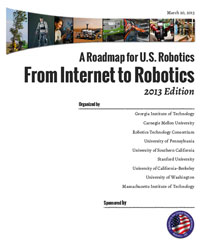| Mar 26, 2013 | |
U.S. Congress releases 'A Roadmap for U.S. Robotics: From Internet to Robotics' |
|
| (Nanowerk News) Last week, the Robotics Caucus Advisory Committee of the U.S. Congress hosted a briefing to present "A Roadmap for U.S. Robotics: From Internet to Robotics–2013 edition". | |
 Last year, robotics celebrated its 50-year anniversary in terms of deployment of the first industrial robot at a manufacturing site. Since then, significant progress has been achieved. Robots are being used across the various domains of manufacturing, services, healthcare/medical, defense, and space. Robotics was initially introduced for dirty, dull, and dangerous tasks. Today, robotics are used in a much wider set of applications, and a key factor is to empower people in their daily lives across work, leisure, and domestic tasks. Three factors drive the adoption of robots: i) improved productivity in the increasingly competitive international environment; ii) improved quality of life in the presence of a significantly aging society; and iii) removing first responders and soldiers from the immediate danger/action. Economic growth, quality of life, and safety of our first responders continue to be key drivers for the adoption of robots. Robotics is one of a few technologies that has the potential to have an impact that is as transformative as the Internet. Robotics is already now a key technology for inshoring of jobs by companies such as Apple, Lenovo, Tesla, Foxconn, and many others and citizens who used to have to rely on family or nurses for basic tasks such as shaving, preparing a meal, or going to the restroom are having a higher degree of independence. In the aftermath of the earthquake in Fukushima, it was evident that it would be a challenge to get an actual sense of the resulting destruction without the deployment of robots for assessment of the magnitude of the damage and assessment of the environmental impact. A similar use of robot systems was also demonstrated in the aftermath of the well blowout in the Gulf of Mexico. |
|
| To fully evaluate the potential of using robotics across the set of available applications, a group of more than 160 people came together in five workshops to identify: i) business/application drivers; ii) the current set of gaps to provide solutions to end-users; and iii) R&D priorities to enable delivery on the business drivers. The meetings were topical across manufacturing, healthcare/medical robotics, service robotics, defense, and space. The workshops took place during the second half of 2012. At each workshop, there was a mixture present of industry users, academic researchers, and government program managers to ensure a broader coverage of the topics discussed. Robotics is one of a few technologies capable of near-term building new companies, creating new jobs, and addressing a number of issues of national importance. | |
| This report is a follow-up to the CCC-sponsored roadmap that was published in May 2009 and presented to the Congressional Caucus on Robotics on May 21, 2009. That roadmap subsequently led to the creation of the National Robotics Initiative (NRI), which is jointly sponsored by NSF, USDA, NASA, and NIH. The NRI was launched in 2011. The present roadmap is an update to the former document in the areas of manufacturing, healthcare/medical, and service robotics. In recognition of the important role that space and defense robotics has both to R&D but also as early adopters, new chapters were added for those areas. These new sections should primarily be seen as identifying areas with dual and multiple-usepotential and areas with a clear potential for multi-domain coordination. As such, the space and defense sections are complementary to independent roadmaps developed by agencies within those domains. | |
| The update of the roadmap has been organized by the Robotics Virtual Organization | |
| Roadmap Results: Summary of Major Findings | |
|
|
| Source: Robotics Caucus Advisory Committee |
